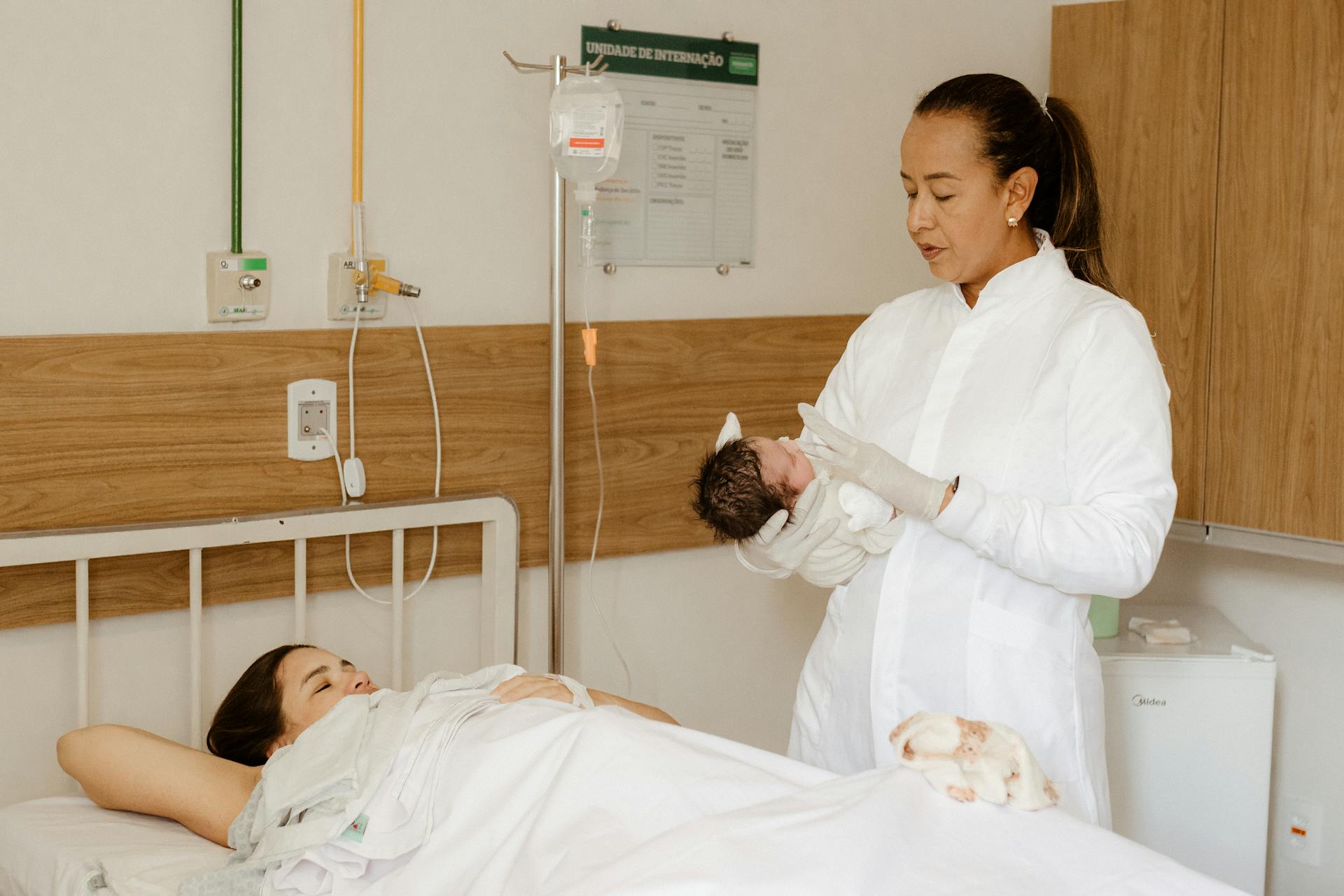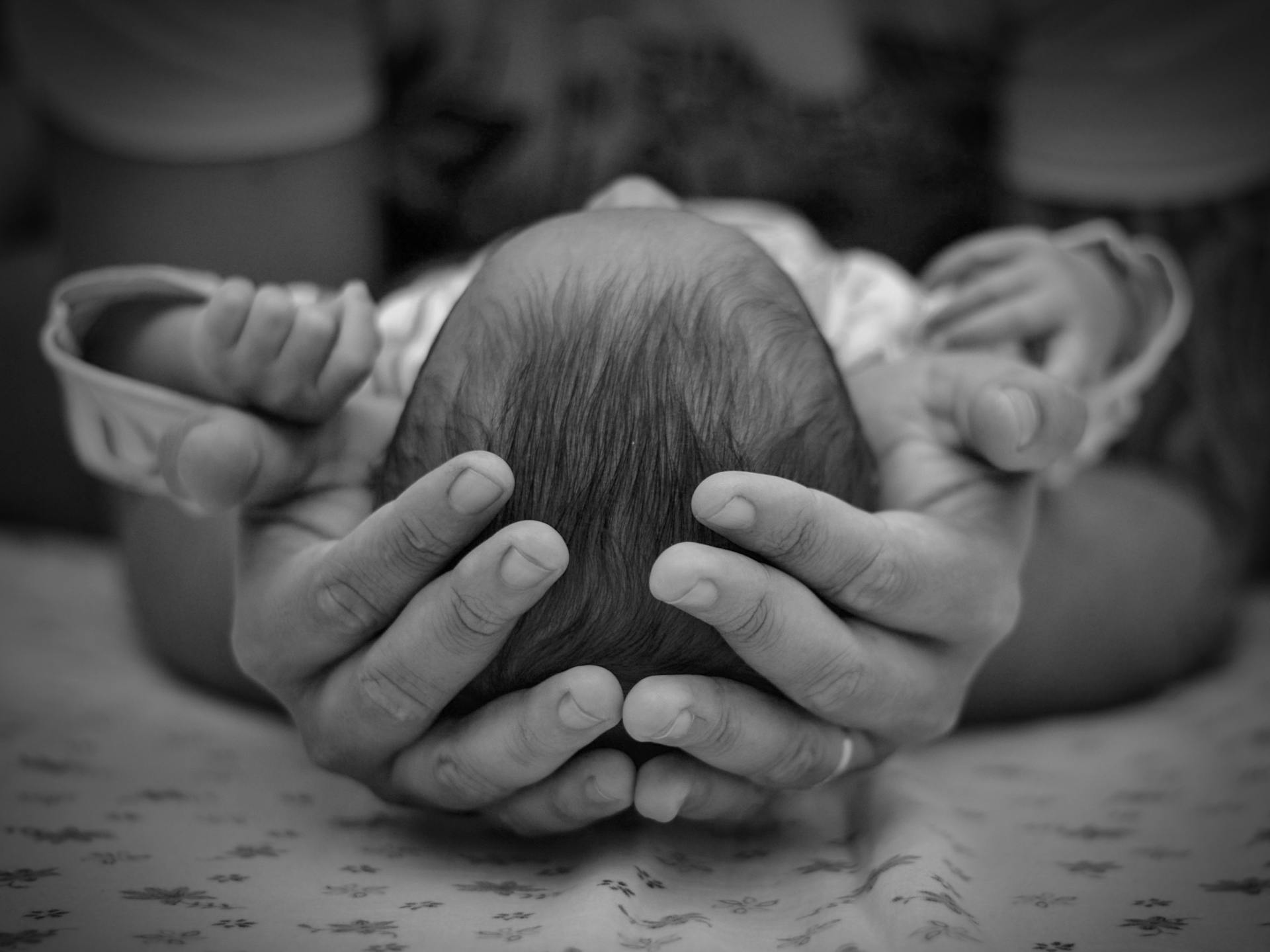
Welcoming a new litter of puppies into the world is a momentous occasion for any dog owner. After a female dog gives birth, she will likely need time to rest and recover, so it's essential to provide her with a quiet and comfortable space to do so.
The average gestation period for dogs is around 58-68 days, but the exact duration can vary depending on factors such as breed and size.
A healthy female dog should be able to take care of her newborn puppies on her own, but it's crucial to monitor her behavior and overall health to ensure everything is going smoothly.
Explore further: Why Is My Female Dog Whining All of a Sudden
Preparing for Birth
As the due date approaches, you'll want to set up a whelping box for your dog. A whelping box is a safe, warm, and easily cleaned location for your dog to have her puppies. You can purchase a whelping box or even use a small children's plastic swimming pool.
You might like: Female Dog Whelping Signs
It's essential to introduce your dog to the whelping box before labor to prevent her from delivering in an unexpected location. You want her to feel comfortable and secure in the whelping box.
A whelping box should be easy for the mother to get in and out of, but not the puppies. You'll also want to place it in a quiet area of the house, but somewhere you can easily access.
To prepare the whelping box, line it with newspaper, sheets, or a mat to make cleanup easier. A large amount of fluid will be produced during whelping, and you'll want to be able to take out soiled layers without disrupting the mother.
Here's a list of essential items to have in your whelping box:
- Lots of newspaper for easy cleanup
- Non-skid bath mats for bedding after whelping is done
- Dry, clean towels to clean the puppies
- Paper towels to help with clean up
Remember to also have a thermometer on hand to check your dog's temperature before whelping, and clean, sterilized scissors to cut the umbilical cords.
Nutrition and Health
As your dog enters the post-birth stage, her nutritional needs will shift to support milk production for her puppies. Your veterinarian will recommend a diet specifically formulated for lactation and reproduction.
See what others are reading: Will Spaying a Female Dog Calm Them down
After giving birth, your dog's energy needs will increase significantly, and she may require two to four times the number of calories she was eating before becoming pregnant. This is crucial for producing milk for her puppies.
Feed your dog a diet approved for lactation/reproduction, often the same as a puppy or growth food.
A unique perspective: Can I Bathe My Dog before She Gives Birth?
Proper Nutrition
As a responsible dog owner, it's essential to ensure your pregnant dog receives proper nutrition to stay healthy throughout her pregnancy.
For the first two-thirds of her pregnancy, you won't need to make any changes to her diet if she's already on a good quality dog food and is at a healthy weight.
Increasing her food intake at this stage can be harmful, so it's crucial to stick to her regular feeding schedule.
However, as her weight increases in the last weeks of her pregnancy, veterinarians recommend increasing her food intake gradually, until she consumes 35-to-50 percent more than usual.
This can be achieved by feeding her small, frequent meals, as large meals can cause discomfort.
You should also consider switching her to a high-calorie diet that contains the necessary nutrients for a healthy pregnancy after about four weeks.
For another approach, see: Food to Clean Dogs Teeth
Health Signs to Watch For

As a dog owner, it's essential to keep an eye out for any unusual signs that may indicate a problem with your dog's health, especially during pregnancy and after giving birth. A fever is a common sign that your dog may be experiencing, so be sure to check their temperature regularly.
If you notice any unusual vaginal discharge, it could be a sign of an infection. However, it's essential to note that some discharge is normal during the first 6 weeks after giving birth.
Lack of milk production is another sign to watch out for, as it can be a sign of an underlying issue with your dog's mammary glands. Pain, redness, itching, swelling, and abnormal-colored milk are all symptoms of mastitis, a painful infection of the mammary glands.
Keep an eye out for lethargy, vomiting, and decreased appetite, as these can be signs of a more serious issue. If you notice any of these symptoms, it's crucial to contact your vet as quickly as possible.
Here are some common signs to watch out for:
- Fever
- Vaginal discharge
- Lack of milk production
- Pain, redness, itching, swelling, and abnormal-colored milk (mastitis)
- Lethargy
- Vomiting
- Decreased appetite
Pregnancy and Birth
A veterinarian can diagnose pregnancy in dogs in several ways, including abdominal ultrasound, blood test for relaxin, abdominal palpation, and abdominal X-rays.
Pregnant dogs typically take up to 24 hours to become restless and anxious, and may start nesting behavior. They will likely not be interested in food starting about 24 hours before labor. A mother dog's temperature will typically drop below 100 degrees Fahrenheit within 24 hours of whelping.
During labor, a dog will strain, and you may notice clear, red, or yellowish vaginal discharge. The first puppy should be delivered within 1-2 hours of the onset of contractions and straining. If labor is not progressing, call your veterinarian immediately.
It's normal for a dog to give birth to puppies either head or tail first, and they can take a break and wait up to 4 hours between puppies. After giving birth to each puppy, the mother dog will pass fetal membranes, which are greenish-black colored masses.
Here are some normal signs of whelping:
- Becoming restless
- Hiding away
- Panting
- Eating less
- (contact your vet if you are concerned or she vomits a lot)
- ‘Nesting’ – digging, pacing and circling around her whelping box
- Passing a small amount of red/brown mucus from her vulva and having very weak contractions (but not straining)
Diagnosing Pregnancy in Dogs
Diagnosing pregnancy in dogs is a crucial step in ensuring the health and well-being of both the mother and her unborn puppies. A veterinarian can diagnose pregnancy in dogs through various methods.
Abdominal ultrasound is the most reliable way to diagnose and check pregnancy, allowing veterinarians to see the developing embryos at around three weeks after breeding. This method is particularly useful for monitoring the development of the puppies and getting an exact count of puppies to expect.
Blood tests for relaxin can also be used to diagnose pregnancy, as relaxin is a hormone made by the placenta that can be detected around 22 to 27 days after breeding. However, this method may not be accurate in small or toy dog breeds, especially if they only have one or two puppies.
Veterinarians can also use abdominal palpation to diagnose pregnancy, where they press on the abdomen and can feel swellings in the uterus where the puppies have implanted. Some veterinarians can even count puppies during palpation.
Here's an interesting read: Breeding Rottweilers
Abdominal X-rays, or radiographs, can be used in the last trimester of pregnancy to count the number of fetuses, as the bony structures of the puppies are picked up on X-ray.
Here are the different methods veterinarians use to diagnose pregnancy in dogs:
- Abdominal ultrasound: most reliable method, detects developing embryos at 3 weeks after breeding
- Blood test for relaxin: detects hormone around 22-27 days after breeding, may not be accurate in small breeds
- Abdominal palpation: feels swellings in the uterus, some veterinarians can count puppies
- Abdominal X-rays: counts number of fetuses in the last trimester
What's Normal During Birth
During a dog's pregnancy, it's essential to understand what's normal during birth to ensure you're providing the best care for your furry friend. Puppies generally come out headfirst or tail first with their legs extended straight.
It's not uncommon for a female dog to take up to two hours between each puppy, but if more than two hours have passed without another puppy being born, you should contact a veterinarian. This is especially true if you're expecting more puppies.
Some dogs may be okay with their pet parent hanging around during the birthing process, but many prefer to give birth alone. If your dog makes more progress when left alone, you can watch from afar, check in at regular intervals, or set up a whelping camera.
For more insights, see: Yorkshire Terrier Giving Birth

If a puppy looks stuck, contact your veterinarian for advice, as you should not attempt to help with the physical act of birthing. It's also normal for mother dogs to eat their placentas, which may result in diarrhea.
After your dog is done giving birth, you may notice vaginal discharge called lochia, which can have a green, red, or brown hue. This discharge can last for around three weeks, but in some cases, it can continue for up to two months. If you notice a foul odor or an increase in discharge, contact your veterinarian.
Here are some signs that indicate your dog is giving birth:
• Becoming restless
• Hiding away
• Panting
• Eating less
• Passing a small amount of red/brown mucus from her vulva and having very weak contractions (but not straining)
• Nesting – digging, pacing, and circling around her whelping box
For more insights, see: Pitbull Dog Birth
Potential Complications
Potential complications can arise during or after whelping. If your dog's rectal temperature drops more than 24 hours ago and labor isn't starting, it's a sign of potential trouble.
On a similar theme: Dog Names Female Start with S
Some warning signs of serious complications include trembling, collapsing, or shivering, which can put both the mother and puppies at risk. If your dog shows no signs of whelping 64 days after her last mating, it's a cause for concern.
Other potential complications include:
- Your dog exhibiting severe discomfort or not delivering the first puppy 2 hours after contractions begin, especially if she has passed green discharge.
- More than 2 hours passing in between the delivery of puppies, or your dog experiencing strong contractions for an hour without a birth or if the mother seems exhausted.
- Your dog not passing all of the placentas, or puppies not nursing.
- Green discharge before the first puppy is born.
Contact your veterinarian urgently if your dog has been straining for 20-30 minutes without producing a puppy – there may be a problem.
Dog Labor Complications
Dog Labor Complications can be a stressful and worrying time for dog owners. If you notice any of the following signs, contact your veterinarian immediately:
Your dog's rectal temperature has dropped more than 24 hours ago and labor isn't starting.
The mother is exhibiting symptoms of severe discomfort, or if she doesn't deliver the first puppy 2 hours after contractions begin, especially if she has passed green discharge.
More than 2 hours pass in between the delivery of puppies, or your dog experiences strong contractions for an hour without a birth or if the mother seems exhausted.
Trembling, collapsing, or shivering are warning signs of serious complications that could put both the bitch and the puppies at risk.
It's normal for dogs to deliver a dark green or bloody fluid after the first puppy, but if this happens before the first puppy, call the vet.
Your dog shows no signs of whelping 64 days after her last mating.
All of the placentas aren't delivered.
Puppies aren't nursing.
Some common complications during whelping include dystocia, or difficulty giving birth, which is especially common in flat-faced breeds such as Pugs, Bulldogs, and French Bulldogs. If your dog is having trouble giving birth, contact your vet straight away and try to give as much detail about her and the pregnancy as possible.
Signs of dystocia include:
- Puppy stuck inside the pelvis or part way out
- Large puppies, deformed puppies, and puppies delivered backwards
- Failure to deliver a puppy after 1-2 hours of contractions
- Failure to deliver a placenta after a puppy is born
In these cases, your vet may need to perform an assisted delivery, a caesarean section, or other interventions to help your dog and her puppies.
Stillborn Puppies
If your dog gives birth to stillborn puppies, it's essential to have her checked over by a veterinarian as soon as possible.
Always have your dog checked over if she gives birth to any dead puppies.
Post-Birth Care
After the birth, it's essential to call your veterinarian right away to ensure everything went smoothly and to get advice on the next steps.
You'll need to remove the umbilical cord and any remaining fluids from the puppies' bodies, taking care not to damage their organs. The mother will also need to remove the fetal membrane, but if she doesn't, you'll need to do it yourself.
The mother will need to be fed a diet approved for lactation/reproduction, which is often the same as a puppy or growth food, and she may need two to four times the number of calories she was eating before becoming pregnant.
Caring for New Puppies
Newborn puppies are fragile and need special care. They are born with a protective fetal membrane that is removed by their mother, but if she doesn't do it, you'll need to.
You may need to break the sac, wipe away any fluids from their nostrils, face the puppies head down, open their mouth, and stroke their body with a towel to remove any remaining fluids.
It's essential to keep an eye on the puppies to make sure they are breathing normally and nursing within a few hours of birth.
If the mother doesn't remove the umbilical cord, you'll need to break it gently about an inch away from the puppy's body, using your thumb and first two fingers.
You should wipe the abdomen of all the puppies with iodine to prevent infection.
Here's a list of things to keep in mind when caring for newborn puppies:
- Keep them warm in their whelping box with a light towel over them to prevent chilling.
- Monitor their breathing and nursing within a few hours of birth.
- Be prepared to break the umbilical cord if the mother doesn't do it.
- Wipe their abdomen with iodine to prevent infection.
The mother should also sever the umbilical cord as she cleans her pups, but if she doesn't, it's up to you to snip the cord and tie it off with some unwaxed dental floss.
Newborn puppies need to be kept warm, so make sure their whelping box is at a comfortable temperature, around 22°C.
Exhaustion
Dogs can become exhausted during labor, especially if it's a long process or if they're an older dog with less energy to start with.
If your dog's labour continues for a long time, she may need some help from your vet.
You'll know your dog is exhausted if she stops straining and shows no signs of pushing or trying to give birth.
Sources
- https://www.akc.org/expert-advice/dog-breeding/dog-pregnancy-care-prep/
- https://www.michigananimalhospital.com/site/blog/2021/11/30/dog-pregnant-signs
- https://www.petmd.com/dog/conditions/reproductive/dog-pregnancy
- https://www.pdsa.org.uk/pet-help-and-advice/pet-health-hub/other-veterinary-advice/whelping-a-guide-to-your-dog-giving-birth
- https://thecovevets.com/blog/labor-delivery-in-dogs-what-to-expect-when-your-dogs-expecting/
Featured Images: pexels.com

